
 |
|
#1
|
|||
|
|||
|
I am curious what you all have seen for different bracing on acoustics.
It seems that what we see generally is either adi or sitka bracing. Then there are some laminated/truss braces. There is a small builder here locally who does not play by the rules at all, is constantly trying new things. He built a parlor and used Port Orford Cedar, and it played and sounded quite nice. Another top he had a very different design, an "X" but the other braces were curved almost like a go cart track for lack of a better analogy. He used a thick piece of cedar, designed the bracing pattern, then used his CNC machine to remove material, leaving the bracing as part of/connected to the cedar top. It too played and sounded nice. Not sure what he did after the CNC part of it, shaving, fine tuning, etc....... I would guess no tap tone on a 5/8" or so thick piece of cedar prior to the CNC !!!!! Any of you have unusual bracing stories?
__________________
A few guitars, subject to change..... Last edited by okeem22; 10-04-2016 at 04:59 AM. |
|
#2
|
|||
|
|||
|
I do lots of experimental bracing. I'll probably write a book in 10 years or so after I've had time to test more of my theories.
Here was my first experiment with a rosewood top back in 2011. 16" lower bout, .070" thick. Lots of warping, high action, and the bridge is mostly detached, but surprisingly it's still playable. Loud and bassy. 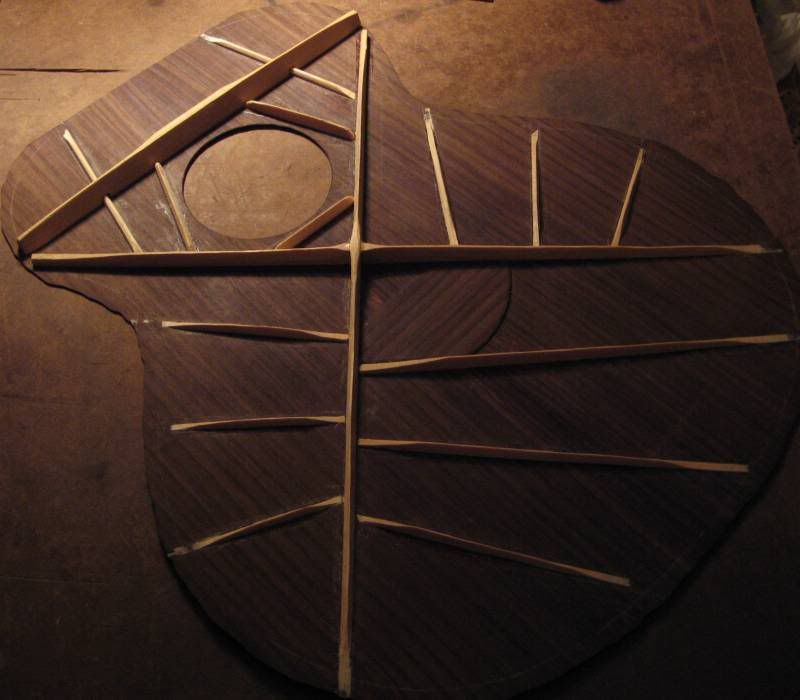 And here's a recent one. 15" lower bout, again .070" thick, but this time with highly interconnected bracing so the plate is never left to fend for itself. Not as loud as the other, but more balanced sound. Quite similar to a typical spruce top, actually. 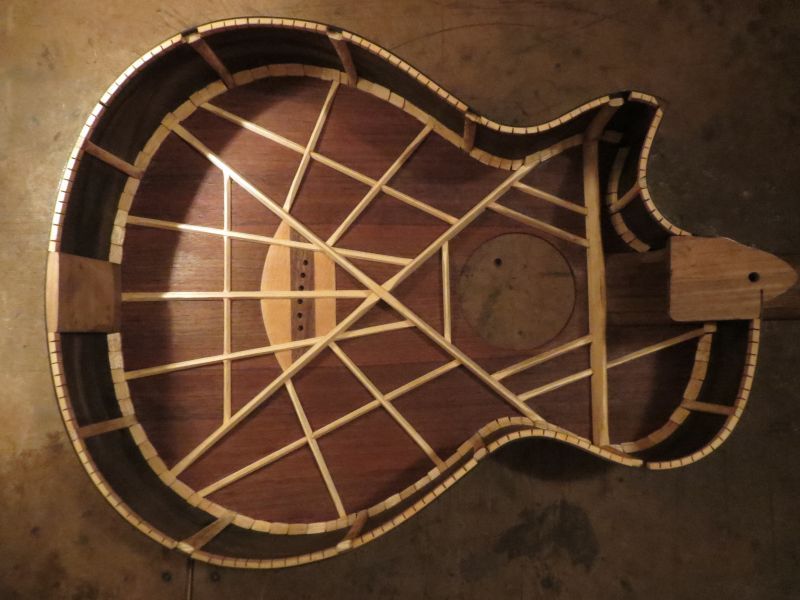 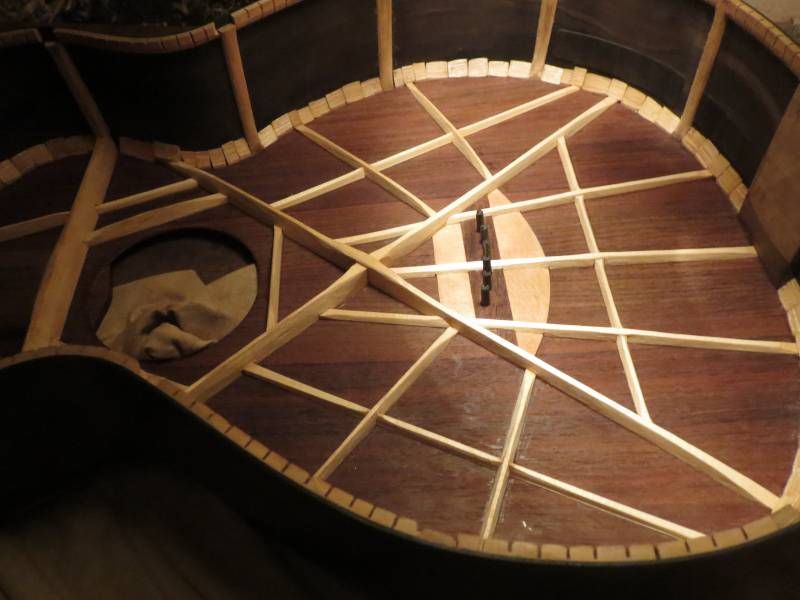 This one is an experiment in minimalist bracing. 14" lower bout, sinker redwood, .150" thick in the middle down to .090-.100" at the perimeter. Sounds great, and bridge rotation under string tension is plenty low. I may actually shave on the X a little more. 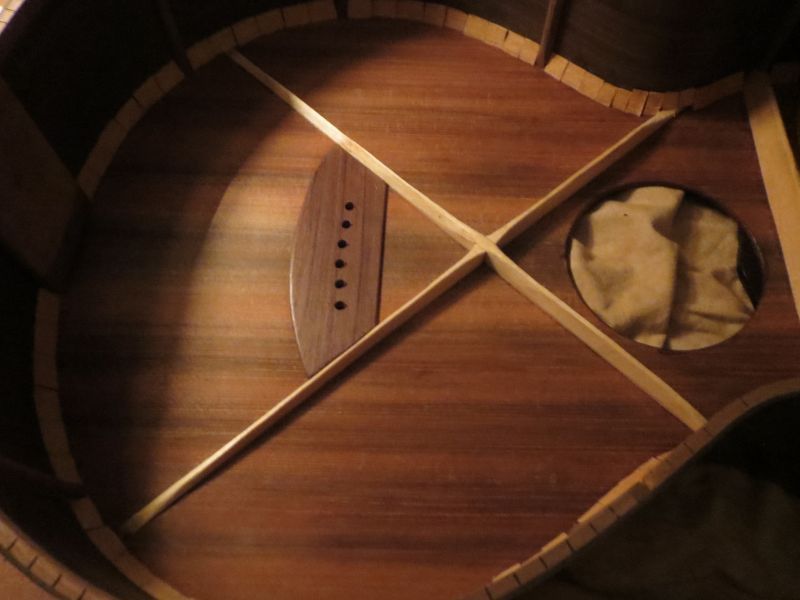 I haven't tried any non-X patterns on steel strings yet, but I do want to try Trevor Gore's falcate pattern. As for materials, Port Orford cedar should indeed be great. It has even higher strength than spruce, so the creep rate should be slightly lower. Redwood and western redcedar, on the other hand, have lower strength, so IMO shouldn't be used for steel strings. You have to make them stiffer and/or wider (and thus heavier) than spruce to keep the long term deformation within acceptable range. I theorize that laminating braces with something super high strength like purpleheart or carbon fiber in the center would reduce long term deformation, at the cost of a small amount more weight in the case of purpleheart or a torn up chisel after carving them in the case of carbon fiber. Soundboards can be low strength because the stress there is distributed over a large amount of wood. Braces need high strength because a lot of stress is focused on a small amount of wood. |
|
#3
|
|||
|
|||
|
not mine but this stuff interests me, check this out -
http://www.acousticguitarforum.com/f...d.php?t=325681 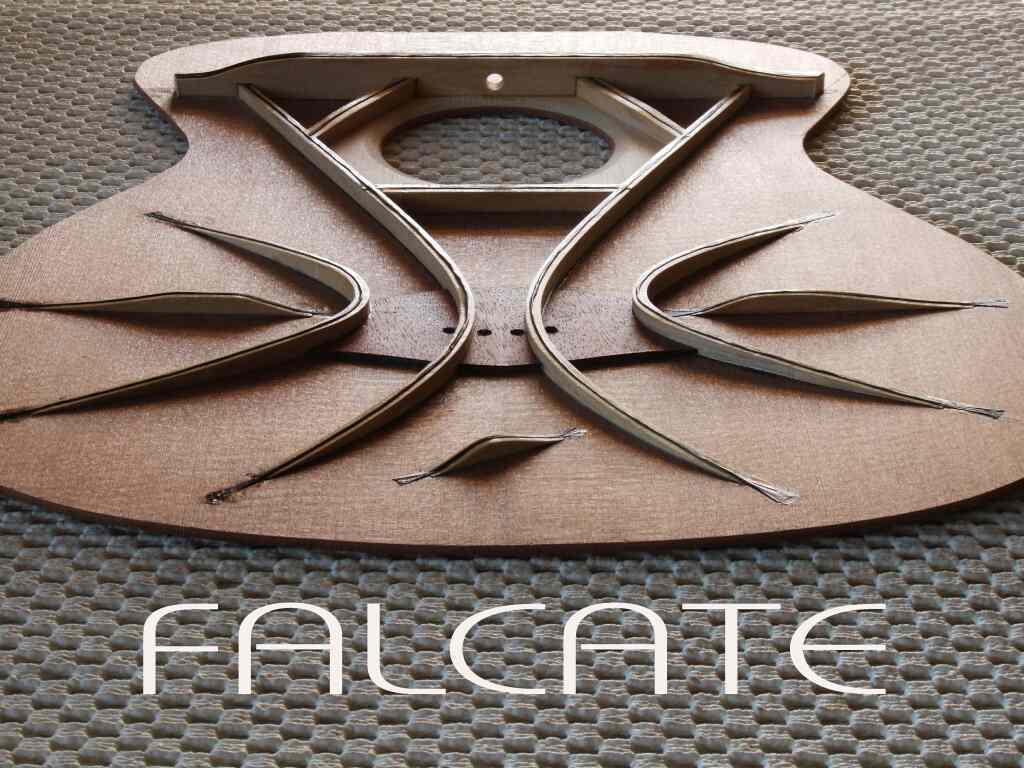
__________________
I play an 'evolved' (modified) Cowboy guitar Not sent from my iPhone using Tapatalk |
|
#4
|
|||
|
|||
|
Thanks all, some cool stuff already. I had not seen nor heard of the falcate bracing either. Definitely interesting. To me it just "looks" like it would work good. Going to do a little surfing/research on it. Thanx.
__________________
A few guitars, subject to change..... |
|
#5
|
|||
|
|||
|
Check out David Anthony Reid if you want unusual bracing. Kevin Ryan's bracing could be something worth checking out too if haven't seen it before
 happy researching! happy researching!
__________________
.
THE GOLDEN ERA GUITAR FOR SALE | VIDEOS AUTHORISED DEALER OF: Astrand | Bowerman | Brondel | Buendia | Casimi | Datlen | Doerr | Fujii | Gerber | GR Bear | Heinonen | Isaac Jang Keith | Keystone | Matsuda | Michaud Made | Ogino | Pellerin | Petros | Poljakoff | Strahm | Tom Sands | Wingert ...and more www.TheGoldenEraGuitar.com [email protected] +65 8666 0420 |
|
#6
|
|||
|
|||
|
Quote:
__________________
Rodger Knox, PE 1917 Martin 0-28 1956 Gibson J-50 et al |
|
#7
|
||||
|
||||
|
The Kasha-influenced builders do some interesting stuff. Check out Steve Klein, Steve Kauffman, Boaz Elkayam, Tom Bills, Jason Harshbarger.
That school of bracing has a very distinctive tone with big bass and a pronounced bloom to the notes. When done well, there's nothing better IMO.
__________________
Solo acoustic guitar videos: This Boy is Damaged - Little Watercolor Pictures of Locomotives - Ragamuffin |
|
#8
|
|||
|
|||
|
Here's another I just remembered. Steve Sheriff's crossover bracing http://www.acousticguitarforum.com/f...d.php?t=282143
It would be interesting to try it on steel strings too. The radial braces should give a nice level of control over the cross dipole and long dipole frequencies, and the curved braces can be beefed up as needed to prevent cave-in. |
|
#9
|
||||
|
||||
|
I'm more intrigued by the use of rosewood as a top. The bracing, I would imagine, could be somewhat more of an afterthought with rosewood than with spruce, no?
|
|
#10
|
|||
|
|||
|
Mark Hatcher's lattice bracing looks fantastic and makes for a remarkably responsive back, especially when he uses red cedar for the braces:

__________________
My YouTube Page: http://www.youtube.com/user/ukejon 2014 Pono N30 DC EIR/Spruce crossover 2009 Pono koa parlor (NAMM prototype) 2018 Maton EBG808TEC 2014 Hatcher Greta 13 fret cutaway in EIR/cedar 2017 Hatcher Josie fan fret mahogany 1973 Sigma GCR7 (OM model) rosewood and spruce 2014 Rainsong OM1000N2 ....and about 5 really nice tenor ukuleles at any given moment |
|
#11
|
|||
|
|||
|
Quote:
Thanks rog. I have never heard a Kasha-influenced build to my knowledge. The pictures I have seen show some very different and refined woodworking.
__________________
A few guitars, subject to change..... |
|
#12
|
|||
|
|||
|
Yes rosewood must 3x the weight.
|
|
#13
|
|||
|
|||
|
Quote:
 But if anything, redwood and cedar are the woods where bracing is an afterthought, since they're so light that you can leave them really thick and they won't be too heavy. Rosewood is about the same stiffness as spruce, but twice the density, so it gets way too heavy if you don't make it thin. And if you do make it thin, then it's way too floppy for traditional bracing. Hence the elaborate lattice pattern. But if anything, redwood and cedar are the woods where bracing is an afterthought, since they're so light that you can leave them really thick and they won't be too heavy. Rosewood is about the same stiffness as spruce, but twice the density, so it gets way too heavy if you don't make it thin. And if you do make it thin, then it's way too floppy for traditional bracing. Hence the elaborate lattice pattern.My next rosewood top will be a smaller guitar, 14" lower bout at most, since that also helps keep the weight down. This 15" one is about 300 grams for the total soundboard mass (including bridge/saddle/pins), which is what I consider to be a good maximum for light gauge steel strings. I want to get down into the 250-275g range and see how it sounds. For comparison, the 14" minimalist redwood is about 230g, and if it was thicknessed and braced more traditionally it would probably be 20-30 grams lighter. But while lighter is pretty much always better for nylon strings, a bit of mass seems to be good for steels. That one confirms my theory that you can safely ignore mass when making small guitars with softwood soundboards, because it's basically impossible to make it too heavy without also making it too stiff. |
|
#14
|
|||
|
|||
 I use Balsa wood cut from billets. In this shot the bracing is at the start of install, so it does not show the entire layout nor final shaping. Balsa has extremely high radiation {speed of sound through the wood}and very low dampening {rate of decay} and works very well with my arched tops and backs. As big as the pieces look in the shot, if you throw them in the air they will float down when they fall. Very light, yet quite strong with a large range of motion.
__________________
http://www.jessupegoldastini.com/ |
|
#15
|
|||
|
|||
|
Quote:
|